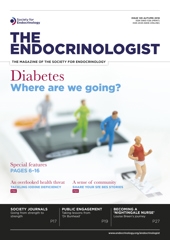I was recently fortunate enough to be able to visit the house in London, Ontario, Canada, where, in 1920, Fredrick Banting awoke from a dream and, in a notebook by his bedside, wrote ‘Ligate pancreatic ducts of dog. Keep dogs alive till acini degenerate leaving islets. Try to isolate the internal secretion of these to relieve glycosuria.’

Banting House, the ‘birthplace of insulin’, in London, Ontario, Canada. Ken Lund. https://www.flickr.com/photos/kenlund/21650600540
This simple recipe led to the isolation and use of insulin to treat type 1 diabetes. Nearly 100 years later, we have access to multiple analogues of the human insulin molecule, all engineered to optimise pharmacology. Alongside these, we have evidence-based education and specialist multidisciplinary teams supporting the 400,000 people with type 1 diabetes in the UK to self-manage as effectively as possible.
However, despite nearly a century of progress, self-management remains challenging, and fewer than one in three people with type 1 diabetes achieves a glycated haemoglobin (HbA1c) level less than, or equal to, 58mmol/mol. Hypoglycaemia, impaired awareness of hypoglycaemia and severe hypoglycaemia remain a major barrier to achieving targets and are associated with significant morbidity and mortality.
THE RISE OF GLUCOSE MONITORING TECHNOLOGY
Continuous glucose monitoring (CGM) has been available for more than 15 years, providing information on the direction, rate and magnitude of glucose changes in real time, with alerts and alarms for impending and established hypo- and hyperglycaemia. While not a recent technology, it has come of age in the last few years with a growing evidence base and inclusion in NICE guidelines for type 1 diabetes for adults and children.
The evidence base now encompasses reductions in HbA1c, minimising exposure to hypoglycaemia and mitigating fear of hypoglycaemia, while real world data suggest CGM can improve work absenteeism. These benefits are seen in people using multiple dose insulin injection regimens as well as in those using insulin pumps, and are seen even in the highest risk people with challenging hypoglycaemia. Next generation devices are being developed with improved accuracy, a longer duration of use and integrated decision support tools.
Flash glucose monitoring (GM) uses a reader or mobile phone to swipe a sensor and report 8 hours of retrospective data, along with a trend arrow. It does not have alerts and alarms, but is licensed to be used without calibration for up to 14 days, enabling people with type 1 diabetes to significantly reduce capillary blood glucose checks. The evidence base is, at present, limited, suggesting no impact on HbA1c and a reduction in time reported below a threshold of 3.9mmol/l in people with type 1 diabetes and an HbA1c less than or equal to 58mmol/mol.
Flash GM and CGM are different implementations of a continuous sensor, and important differences exist in how they may be used to benefit people with type 1 diabetes. Flash GM can act as a replacement for capillary blood glucose testing and CGM can enable optimised glucose outcomes where hypo- or hyperglycaemia is challenging. Cost effectiveness is uncertain for continuous sensors at present, but we are hopefully in a transition phase from routine capillary blood sampling to a blood-free monitoring future for people with type 1 diabetes.
THE QUEST FOR THE ARTIFICIAL PANCREAS

The ‘perpetual flame’ will burn outside Banting House until there is a cure for type 1 diabetes. Ken Lund. https://www.flickr.com/photos/kenlund/21838632935
One of the long-stated goals of type 1 diabetes research has been to develop an artificial pancreas device, encompassing glucose sensing, a control algorithm and an insulin pump. This apparently simple task has been very challenging but, as sensor accuracy has improved and devices have become more usable, longer studies have been undertaken with impressive results.
In 2018, the first hybrid closed loop system has been licensed in Europe. The Medtronic 670G system has a safety algorithm which suspends insulin delivery if hypoglycaemia is predicted, and is able to dynamically adapt the insulin basal rate to increase time spent in the desired glucose range between meals. Users still have to check their capillary blood glucose several times a day and enter carbohydrate information at mealtimes but early data suggest an improvement in overall glucose.
Future systems with more automation and a smaller burden for users, which include additional features such as adaptation to manage day-today variability, are being assessed. In addition, more complex approaches, including glucagon to mitigate hypoglycaemia, have been developed.
Despite these exciting advances, people with type 1 diabetes will continue to benefit from education and support to understand their diabetes. Technology is an adjunct to effective self-management and education will remain key until we have a more lasting treatment for this disorder.
A ‘perpetual flame’ burns outside Banting’s house in Ontario, and will only be extinguished when a cure for type 1 diabetes is developed. Until that time, technologies can support improvements in glucose outcomes and help to reduce the burden of living with the disease. Making technologies available and ensuring that people with type 1 diabetes have access to support and education to extract value from them remains a priority.
Nick Oliver, Wynn Professor of Human Metabolism, Consultant in Diabetes and Endocrinology, Imperial College London








